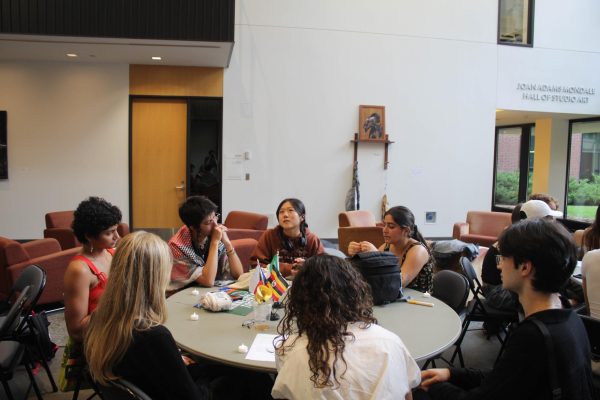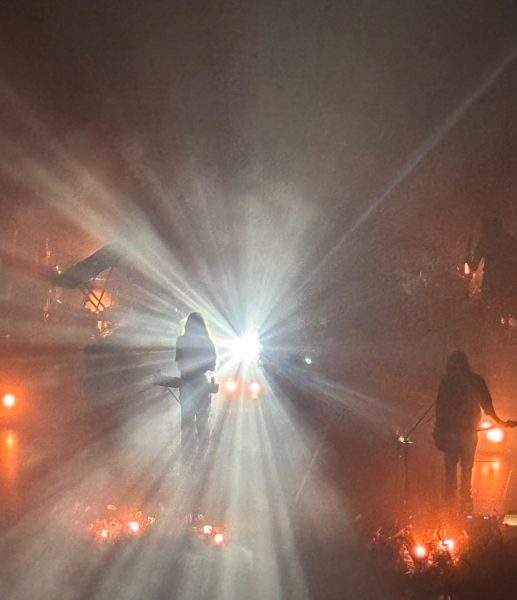Room G103 at Mia: asking the audience to rethink history

September 26, 2019
Located on the first floor of Minneapolis Institute of Art (Mia), “Rethinking Histories: Work from Mia’s Collection” is likely to be ignored by the audience, whose attention might be drawn to the coffee shop nearby. However, the exhibition itself is highly intuitive and inspiring. The art pieces exhibited in the room range from pictures to films and statues, encourage the audience to look back and compare history with today.
Before entering the room, the audience is able to see a stunning picture at the entrance of the exhibit. The photograph, “Portrait of Quzuquzah,” pictures an African-American woman sitting on a 1970s patterned sofa. Echoing the artwork of “Manet: A Bar at the Folies-Bergere,” the photograph and the painting share many similarities. Both pictures focus on a young lady dressed in attire that reveals parts of her cleavage. However, the pictures present a divergence within the feeling of the female character. The main character in Manet’s painting is standing and suffering from the gaze of a man. Leaning her body and restricting her movements, the lady in the Manet’s artwork is very uncomfortable and nervous. However, in “Portrait of Quzuquzah,” the woman sits on a sofa with comfort and relaxation. It’s easy to see how women’s power has changed throughout history. While in 1880, the young lady in the picture was uneasy under the gaze of the man standing in front, the lady in the 2008 work is self-confident and relaxed.
On to the left side of the room is Kota Ezawa’s 2005 work, “The History of Photography Remix.” The artist selected 40 important pictures in the history of photography and converted them into the form of abstract drawing. He proudly claims that the art form of drawing allows the pictures to carry more graphic symbols and obscure meanings. These drawings were made into static animations and projected on the wall. If the audience is not familiar with the history of photography, they are unlikely to understand these pictures. What do these abstract drawings stand for? Which artworks do these projections represent? People tend to accept whatever was said to be the history, even with very minimal understandings about the “history.” Kota Ezawa wanted to use his artwork as a metaphor to encourage people to be skeptical and critical while thinking about history.
Three magnificent artworks were on the other wall. The first is “The Picture of Money” (Sanjusangedo) by Mori Chihiro. Taking a first glance at the artwork, the audience can quickly tell that it is made up of the symbols and fractions printed on Japanese money. However, there are white irregular curves on the graph. If the audience looks closer, they see that these curves are a collage of smiley faces crashing into each other.
Mia described the artwork from Mori as follows: “On top of this colorful web of fractions, Mori painted a sea of smiling faces that represent religious icons in the Sanjusangendo, a Buddhist temple in Kyoto. Mori playfully visualizes a clash of opposing forces—sacred (the Thousand-Armed Kannon) and profane (smiley faces and money), order (organized religion) and chaos (capitalism)—to express her frustration with cultural pressures to conform.”
Next to the artwork of Mori is “Abbott & Cordova, 7 August 1971” by Stan Douglass. The huge picture is made of more than 50 digital photographs that were electronically put together. It demonstrates the 1971 Gastown Riot in a way that Douglass calls “the creation of historical fiction.” In which he juxtaposes symbols from the past and the modern world. The work looks like people from different centuries were brought together and involved in the riot. In the video put next to the picture, the artist expressed his focus about the work.
He incorporated both modern and ancient attire to represent a collision of history and reality. Because it is such a large picture, he had to build a studio that looks like a street and hire actors to get the right image. Focusing on the details of each group of people, he did a magnificent job incorporating the past and present in the same picture. The artwork itself is also a perfect display of how the technology existing in photography now allows for massive digital stitch works that were once impossible.
The stunning sculpture that sits in the middle of the room by Willie Cole is named “Anne Klein With a Baby in Transit.” Instead of using common materials to build the sculpture, Willie used high heels to construct a mother carrying her baby. Cole believes high heels symbolizes the life of women. While these shoes might be worn by more than one woman, each female leaves signs and symbols on the shoes, thus making these shoes meaningful. The statue, made of these shoes, contains the stories and symbols of their owners. Each wrinkle on the shoes, each erosion on the bottom, each hole and each scar on the leather represents the story of the people who once owned these shoes. In the video played next to the artwork, the artist expressed his hope that audiences will be able to see not only the “literal” statue, but also the stories hidden behind the production.
The exhibition aims to encourage the audience to rethink history. Many of the ideas presented in the artwork are not restricted to the exhibition but also extends to the whole exhibition and encourages people to discover the history and the stories that hide behind the art piece. Not only is the exhibition very enjoyable, but Mia also recorded interviews with several artists, which makes the exhibition approachable to the general audience. A common metaphor labels the art world as an “ivory tower,” however, this specific exhibition is very connected with the world.
This exhibition continues until Jan. of next year.












